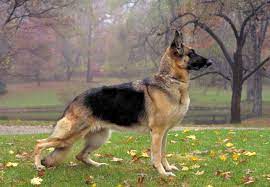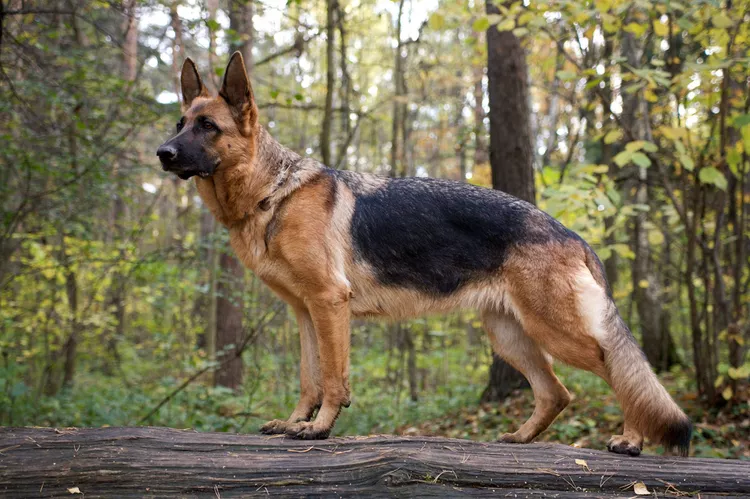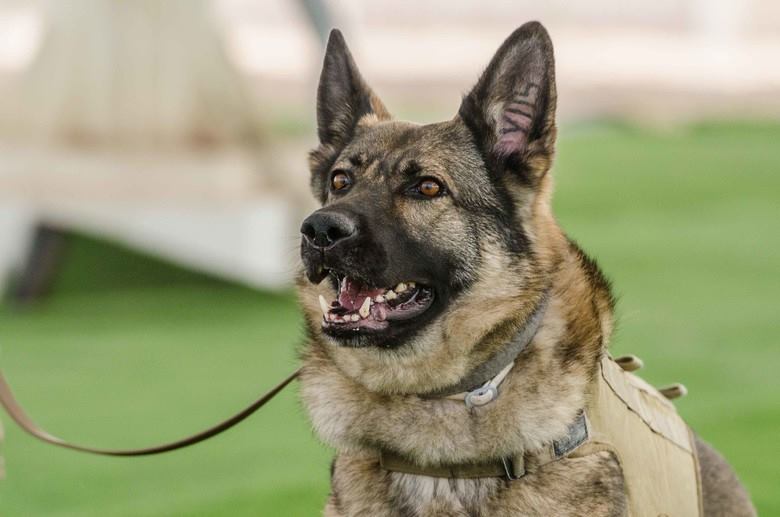German Shepherd Dog Breed Characteristics
The German Shepherd is a beloved breed known for its intelligence, strong sense of loyalty, and versatility. Originating from Germany as a herding dog, it, now known as a prime police dog, has become a favorite for various roles, including police work, search operations, and as a service animal.
These dogs, often showcasing their remarkable attributes at dog shows, carry a striking look, Rin Tin Tin kind of thick coats that stand against severe weather, and a sturdy build aligned with the German Shepherd Dog Club of America dog breed information. They are intelligent and confident but thrive with regular dog training and social interaction. If you’re contemplating bringing home a German Shepherd, be ready to provide ample exercise and engaging activities for mental stimulation, similar to what the American Kennel Club suggests as a guide dog for the blind may need.
German Shepherds, often renowned as search and rescue dogs, serve more roles than just protectors; their temperament also makes them excellent family dogs. They’re loyal companions, making them ideal guide dogs, and they represent a perfect blend of strength and intelligence, complemented by a graceful elegance reflective of the German Shepherd’s temperament.
Key Takeaways
- German Shepherds excel in various jobs and companionship.
- These dogs need regular training and social engagement.
- They possess a blend of strength, intelligence, and grace.
German Shepherds stand out for their brains and loyalty. They demand consistent mental and physical stimulation. As partners, they offer a potent combination of brawn and brain.
Quick Facts
German Shepherds are highly regarded for their intelligence and loyalty, making them a favorite among dog enthusiasts. Max von Stephanitz perfected the breed to create an exceptional herding dog, and its history is closely linked with the Verein für Deutsche Schäferhunde, the breed’s founding club.
These dogs are known for their medium-length double coat that keep them comfortable in different weather conditions. Owners should be aware of the breed’s tendency to suffer from hip and elbow dysplasia, but responsible breeding can help prevent these issues.
German Shepherds are muscular, with males reaching up to 26 inches at the shoulder and females slightly shorter, reflecting their heritage as capable working dogs.
German Shepherd Dog Breed Pictures






Overview
German Shepherds have evolved far beyond their original herding duties. They are now valuable in various roles such as police work and assistance services and as loving pets due to their versatile abilities and even-tempered nature. Recognized for their intelligence, loyalty, and ease of training, German Shepherds have earned the rank of the fourth most popular dog breed by the American Kennel Club.
These dogs have shown remarkable adaptability, thriving in roles that demand sharp senses and quick reactions. Males typically stand between 24 and 26 inches tall, while females are a bit shorter at 22 to 24 inches, which gives them an imposing figure that matches their sharp wits. Their coats come in different types, including long and short hair, with the familiar tan/black or red/black color patterns, making them as attractive as they are effective, whether on duty or as family pets.
German Shepherd Personality and Key Traits

German Shepherd Dogs are known for their intelligence, agility, and strength, making them ideal for roles that demand quick thinking and physical capability. These dogs are famous for law enforcement and search and rescue teams due to their sharp minds and adaptability. Their intelligence stands out, making them quick learners who can handle complex tasks with relative ease. Originally bred to herd, German Shepherds still have a strong instinct to pack and protect, which speaks to their natural ability to take on different jobs effectively.
| Trait | Impact on Role |
|---|---|
| Temperament | Perfect for protection |
| Intelligence | Simplifies training |
| Agility | Suited for active jobs |
| Herding Instinct | Innate ability to herd |
German Shepherds are intelligent and have a temperament that makes them reliable for protective roles. Their agility allows them to excel in physically demanding jobs that require quick reflexes and movement. The herding instinct in their bloodline is evidence of their inherent ability to guide and safeguard, proving their adaptability across various tasks.
Breed Origins

The German Shepherd Dog is recognized for its sharp intelligence and ability to take on various roles. Originating in the late 19th century, the breed was meticulously developed to be a multifunctional herding dog that could guard and protect. The ancestry of the German Shepherd contributes significantly to its intense genetic makeup. These dogs were bred for their ability to work effectively and adapt to different situations.
The early formation of the breed was heavily influenced by local herding dogs prevalent in the region at that time. As Society’s needs changed, so did the roles of the German Shepherd, leading to its evolution in physique and temperament. Visionary breeders played a pivotal role in refining the breed into the well-known and respected dog breed we see today, valued as much for companionship as for its working capabilities.
Ancestral Lineage
Researching the origins of the German Shepherd breed takes us back to Germany in the late 19th century when a concerted effort was made to create a skilled working dog with appealing looks. The Phylax Society initially set out to standardize working dogs, but Max von Stephanitz took a pivotal step in 1899. He formed the Verein für Deutsche Schäferhunde, which translates to the Society for the German Shepherd Dog, and coined the breed’s name, Deutscher Schäferhund.
Horand von Grafath, the Society’s inaugural registered dog, laid the genetic foundation for German Shepherds. Stephanitz had a clear vision for the breed, focusing on their ability to work and intelligence. He blended various herding dog bloodlines, aiming to produce a dog breed that stood out in its appearance and capacity for work.
Historical Purpose
The German Shepherd Dog owes its existence to the meticulous breeding efforts of Max von Stephanitz, who focused on creating a dog that could effectively herd and guard sheep. These dogs were selected for their intelligence, strength, and adaptability, traits necessary for managing livestock.
Horand von Grafrath, the original dog registered by Stephanitz, exemplified the ideal qualities desired in the breed, which combined excellent herding abilities with a strong protective instinct.
The German Shepherd’s origins are firmly established in practical utility and a strong work ethic, allowing the breed to excel beyond pastoral duties and adapt to various roles, showcasing its versatility and lasting significance.
Evolutionary Changes
The transformation of the German Shepherd from a simple herding animal to a multifaceted dog showcases the careful breeding choices made throughout its history. Pioneers like Max von Stephanitz and the Society for the German Shepherd focused on breeding intelligent, quick, and dependable dogs, valuing their working ability over their looks. This approach resulted in a breed renowned for its adaptability, smoothly transitioning from herding to roles in service.
Recent breeding practices, however, have sometimes prioritized physical traits, leading to health problems such as degenerative spinal stenosis. This issue highlights the need to balance a dog’s physical form and functional abilities.
German Shepherd Appearance and Physical Dimensions

The German Shepherd stands out with its notable size and agility, vital for its many roles, from police work to companionship. When looking at a German Shepherd, you’ll notice a muscular yet elegant body, showcasing the breed’s capacity for both strength and speed. These traits are essential for meeting the breed’s standards and their suitability in different jobs.
Height and Weight: These are the basic measurements for gauging a dog’s stature and how well it matches the expected breed profile.
Body Structure: Observing the German Shepherd, you’ll find a sturdy body supported by a robust skeletal structure, signifying their ability to handle rigorous activities.
Coat Length Variations: While most German Shepherds have a dense double coat, some possess a less common long-haired jacket, which doesn’t affect their abilities but does require different grooming.
Size Comparison: Compared to other breeds, the size of a German Shepherd directly affects their versatility and skill set.
Growth Patterns: It’s also vital to understand how German Shepherds grow from puppies into adults, as this influences their health needs and the approach to their training.
Height and Weight
German Shepherds vary in size, with adult females standing around 22 to 26 inches at the shoulder and males slightly taller at 24 to 26 inches. They are a medium to large breed, with weights ranging from 50 to 90 pounds, where typically, females are lighter than males. These measurements showcase the breed’s robust framework and muscular condition, common traits among larger dog breeds.
To keep German Shepherds healthy, monitoring their growth and maintaining a proper balance of nutrition and exercise is necessary. This careful attention helps prevent common, more significant breed problems like hip dysplasia. It’s also essential to regulate their weight to avoid putting extra stress on their joints.
Body Structure
German Shepherds possess a strong and balanced build suitable for various work roles, thanks to their history as multi-purpose working dogs. They have a broad chest, a level back, and well-muscled legs, which underline their physical capabilities. Their heads feature a pronounced square-shaped muzzle, and their tails are bushy, adding to their imposing appearance.
Their fur consists of a thick outer layer that shields them from the elements and a soft underlayer for thermal insulation. This combination is vital for the dogs to adapt to different weather conditions. Due to their size and high energy levels, German Shepherds are regularly checked for hereditary health issues, especially those affecting their bones and joints, which are crucial for their active lifestyles.
Coat Length Variations
German Shepherds showcase a variety of coat lengths, from the more typical medium-length coats to the rarer long-haired ones. Both types have their benefits for the dog’s well-being and appearance.
A medium-length coat has a tough outer layer and a soft undercoat that protects the dog from various weather conditions. Regular grooming is necessary, especially for black German Shepherds and the less common white variety, to keep their coats healthy and manage shedding.
On the other hand, the majestic long-haired German Shepherd may not have a thick undercoat, but its impressive long fur is visually appealing. Owners should groom these dogs consistently to prevent tangles and maintain the coat’s natural shine.
Regardless of the coat length, German Shepherds are a versatile breed, able to adapt to various climates and lifestyles with proper care.
Size Comparison
A German Shepherd stands out with its larger size, making it an excellent choice for demanding jobs such as police and military work and search and rescue operations. They’re also affectionate and protective, making them ideal as family pets.
Equipped with a solid build, male German Shepherds weigh between 65-90 pounds and have a height of 24-26 inches at the shoulder, while females are generally lighter at 50-70 pounds and shorter at 22-24 inches.
Their well-proportioned body is a critical asset in their active roles, combining strength and agility with their well-known intelligence, shaping them into a capable and versatile breed.
Growth Patterns
German Shepherd puppies go through a phase of fast growth and usually reach their adult size between 18 and 24 months. Noticeable changes mark this time as they grow from playful pups into strong, muscular adults.
Their growth isn’t just a straight line; they have periods of quick growth and times when it slows down. Good nutrition, regular exercise, and consistent training are vital to help these dogs grow well and reach their genetic potential.
Keeping an eye on their growth is crucial because unusual changes might signal health problems. Knowing how a German Shepherd grows helps owners care for their dogs during these critical early years.
Behavioral Traits
German Shepherd Dogs are known for their complex behaviors, which reflect their diverse history in various roles. Recognizing and properly managing these behaviors is critical for owners who want to see their dogs excel as workers and devoted pets. We’ll discuss some essential traits of conduct to be aware of:
Training Readiness: German Shepherds are quick learners and aim to please, making them responsive to training efforts. They need a consistent and patient trainer to guide them.
Need for Socialization: Introducing them to different settings and people early on is vital to prevent them from becoming overly protective and to develop a friendly nature.
Controlling Prey Drive: Their strong prey drive should be directed positively. This prevents them from chasing after smaller animals and maintains safety.
Understanding Aggression: Identifying and mitigating factors that might cause aggression is essential. This helps them get along better in human and animal communities.
Managing Protective Instincts: Their inclination to protect is beneficial but must be handled carefully. Owners should train them to be assertive without being aggressive.
Training Responsiveness
German Shepherd Dogs are highly regarded for their quick learning and obedience during training, making them famous for various service roles. Their high intelligence allows them to understand and follow complex instructions with ease. These dogs excel in structured training environments that challenge their minds and satisfy their need for engaging tasks.
German Shepherds combine their sharp intellect with self-reliance, making them fast learners eager to acquire new abilities. Their dedication and desire to please enhance their ability to perform reliably, especially in demanding tasks requiring cognitive and physical skills.
Socialization Importance
Socializing German Shepherd Dogs during their early months is vital for their development. It shapes their behavior and ensures they grow up to be well-tempered. Introducing them to different people, animals, and environments is critical to cultivating the kind of temperament ideal for a family pet.
A German Shepherd that’s been properly socialized tends to be protective yet gentle. These dogs are better at forming strong bonds with their families and can be effective guard dogs without being overly aggressive, thanks to positive and consistent social interactions.
Prey Drive Management
Training and managing a German Shepherd’s prey drive is vital to living peacefully with other animals and ensuring safety. German Shepherds are known for their sharp sense of smell and strong protective instincts. German Shepherds need a well-planned training regimen.
Introducing them early and consistent obedience lessons to different people and animals helps them manage their instincts. This breed thrives on physical activity and mental challenges to keep them satisfied and sharp-witted.
Engaging them in scent tracking or agility courses positively uses their natural abilities. These steps help direct their energy and instincts in a beneficial direction, creating a friendly and balanced pet.
Aggression Factors
Understanding how to manage a German Shepherd’s natural tendencies can help prevent aggressive behaviors. Their instinct to protect makes them outstanding guard dogs, but it’s necessary to guide this trait with early socialization to avoid excessive guarding.
A consistent training routine and plenty of mental challenges are vital in directing their energy positively and preventing assertiveness that can lead to aggression.
Exercise is also crucial for maintaining a calm and well-behaved dog. Health issues can cause discomfort and escalate to aggression, so regular veterinary check-ups are essential to keep your German Shepherd in good shape and temperament.
A thoughtful analysis of these aspects will help raise a friendly and well-behaved German Shepherd.
Protective Instincts
German Shepherds are known for their natural guard instincts, which make them dependable protectors when trained well. These traits make them stand out as family pets and service dogs in various roles, such as police and military work.
They are fiercely loyal and have an innate desire to protect, so many families trust them for added safety at home. For German Shepherds to reach their full potential and avoid unwanted aggressive behavior, starting socialization and training early is necessary. This approach ensures they respond appropriately to threats, reinforcing their role as disciplined and reliable guardians.
German Shepherd Health Conditions & Management
German Shepherd Dogs are intelligent and adaptable, but they have their share of health issues that owners should actively manage. Carefully examining their health can help reduce the chance of genetic and lifestyle diseases. To keep these dogs healthy, owners should use a well-rounded strategy that includes:
- Early tests for genetic conditions are expected in the breed.
- Regular health maintenance to prevent diseases.
- Strategies for improving their overall lifespan.
- Special diets that support their bones and joints.
- Looking into insurance for health issues common to German Shepherds.
Owners must be proactive with veterinary screenings to catch any health problems early. Preventive care, such as vaccinations and regular check-ups, is critical to avoiding common ailments. Improving a dog’s quality of life can involve regular exercise and mental stimulation, which are vital for this active breed.
Creating a diet tailored to the needs of German Shepherds can help maintain their joint and bone health, which is crucial due to their size and activity level. Lastly, considering pet insurance might be a wise choice, as it can help cover the costs of breed-specific conditions that may arise.
Common Genetic Disorders
Genetic disorders like hip and elbow dysplasia, degenerative myelopathy, and exocrine pancreatic insufficiency are significant health issues for German Shepherds and must be managed with care.
These dogs often suffer from hip dysplasia, with studies showing around 19% of the breed is affected, highlighting the need for routine vet visits and genetic screenings.
Early identification of degenerative myelopathy is possible with DNA tests that can be done using a dog’s saliva.
Managing exocrine pancreatic insufficiency involves close monitoring of digestion and adding necessary enzymes to a dog’s diet.
While Von Willebrand’s disease is less common, it’s still a concern that requires attention to ensure the overall health of these dogs.
Responsible breeding and knowledgeable care are critical in addressing these inherited conditions.
Preventative Health Measures
To maintain the health of German Shepherd Dogs, it’s vital to schedule regular vet check-ups and monitor their diet and exercise. These steps help catch conditions like hip and elbow dysplasia early and slow their progression. Responsible breeding includes genetic tests to lower the chance of passing on health issues.
Feeding German Shepherds a diet with the right amount of calcium is vital for their bone health. Regular, structured exercise keeps their energy in check and helps to avoid putting extra strain on their joints. Balancing their active lifestyle with sufficient rest is essential.
Lifespan Optimization Strategies
To maintain the health and longevity of German Shepherd Dogs, owners must adopt a holistic approach to their care. This means being proactive about their unique health needs, such as hip and elbow dysplasia, and incorporating exercises that support joint health into their daily routine. It’s also vital to include joint supplements to aid in maintaining mobility.
Regular visits to the veterinarian are crucial for early detection and treatment of issues like degenerative spinal stenosis and myelopathy. Grooming is more than just keeping your dog looking good—it’s about keeping their skin healthy and can often give you early signs of internal issues.
With the breed’s popularity, investing in quality food, consistent exercise, and a good pet insurance plan to help with hereditary health issues and veterinary costs makes sense.
Maintenance & Well-being
Caring for a German Shepherd involves various aspects essential for their health and happiness. If you’re dedicated to your German Shepherd, you must focus on a complete care plan that includes grooming, exercise, and proper diet.
Grooming is vital: Frequent brushing helps control shedding and keeps skin healthy. Exercise is non-negotiable for a German Shepherd; they need plenty of activity to use their energy and keep their muscles strong. Their diet should be tailored to support an active life and to address specific sensitivities they might have. It’s also wise to have regular health checks to catch and manage any genetic health issues early.
Mental engagement is another critical area. Training and puzzles can keep their mind sharp and behavior balanced. Focusing on these areas, you can help ensure your German Shepherd lives a long, joyful life.
Grooming Requirements
Caring for a German Shepherd Dog involves a solid grooming routine to keep their unique double coat in top condition and support their health. Regularly brushing your German Shepherd helps manage the constant shedding of their undercoat, especially when they shed the most. It’s best to brush your dog multiple times weekly or even daily when shedding a lot.
Occasional baths, maybe every few months or when your dog gets especially dirty, will keep them clean and smelling fresh.
Regular grooming is also an opportunity to spot early signs of skin issues, which can be expected due to certain breeding practices. Alongside coat care, don’t forget to trim your dog’s nails and clean their ears to prevent discomfort or infections. These practices are critical to your German Shepherd’s comfort and health.
Exercise Needs
German Shepherds need at least two hours of exercise daily to stay physically and mentally healthy. These large dogs naturally tend to be active, tracing their origins as working dogs. Including activities that allow for full-speed running helps tap into their athletic abilities and keeps weight gain in check, which is especially important for larger dogs.
Mental stimulation is just as necessary for these intelligent canines. Agility training or scent games can keep their minds sharp, ensuring they’re physically fit and mentally stimulated. A balanced routine of physical and mental activity helps prevent behavior problems and maintains the overall health of German Shepherds.
Diet & Nutrition
Feeding your German Shepherd the proper diet is essential for their health and happiness. A well-balanced meal plan helps these active dogs avoid weight gain, which can lead to joint problems like hip dysplasia and osteoarthritis—common in the breed.
For growing puppies, it’s vital to watch the calcium-to-phosphorus balance, aiming for a ratio of about 1.2:1 to support healthy bones.
Including omega-3 fatty acids, such as EPA and DHA, in their diet can benefit their joints by slowing down cartilage deterioration. This could ease osteoarthritis discomfort. Dogs with existing joint damage may benefit from added glucosamine supplements.
Also, don’t forget to ensure a good supply of vitamins A and D to aid bone health and calcium absorption.
Health Screenings
Proper nutrition and diet are vital in keeping German Shepherds healthy and happy. To maintain their health, these dogs need regular check-ups to catch any hereditary issues early.
Veterinarians should regularly check German Shepherds for common genetic problems like hip and elbow dysplasia, degenerative myelopathy, and Von Willebrand disease. Good breeders will have documentation of these health screenings. They should also use genetic testing in their breeding programs to help prevent these diseases from being passed to puppies.
Along with health monitoring, feeding German Shepherds the right food and ensuring they get enough exercise is vital for their long-term well-being.
Mental Stimulation
Keeping a German Shepherd’s mind active is vital to their happiness and prevents terrible behaviors. These intelligent dogs need ongoing, diverse challenges to stay sharp and attentive.
Consistent training does more than teach obedience; it is a crucial mental workout for the breed. German Shepherds excel in complex tasks like those performed by search and rescue teams, proving their problem-solving and decision-making skills.
To tap into their intellectual abilities and promote their psychological well-being, owners should engage them in daily activities such as agility and obedience courses. This approach stimulates their minds and strengthens the dog’s and its owner’s bond.
Dietary Requirements
Ensuring a German Shepherd Dog gets the proper nutrition is vital to keeping them healthy, especially since they’re prone to specific genetic issues that can be improved with the appropriate diet. Carefully examining their dietary needs should include a good mix of nutrients, awareness of food allergies, and a consistent feeding routine.
Here’s what to focus on:
- Adjust the proteins, fats, and carbohydrates levels to fuel their energetic lifestyle.
- Include vitamins and minerals to avoid nutritional gaps and support overall well-being.
- Be mindful of the breed’s tendency toward allergies when choosing what to feed them.
- Stick to a feeding schedule that matches their digestive health and keeps their energy up.
- Monitor their weight and body condition to know when to change their food amounts and diet.
Balanced Nutrition Importance
German Shepherds need a well-rounded diet to stay healthy due to their high activity levels and genetic vulnerabilities. They’re at risk for conditions like hip dysplasia and osteoporosis, so they require a diet with enough calcium and a specific calcium-to-phosphorus ratio (1.2:1) for strong bones and to reduce the risk of joint issues.
Adding omega-3 fatty acids, such as EPA and DHA, is essential to help maintain cartilage health and lessen the symptoms of joint conditions. Vitamins A and D are also vital for bone growth and overall metabolism, making a specialized diet critical for these dogs.
Pet owners should consistently monitor their German Shepherd’s weight and provide a balanced diet to avoid obesity and maintain their pet’s health.
Food Allergies Consideration
German Shepherd owners must pay close attention to their dog’s diet to prevent food allergies and sensitivities that can cause health problems. These dogs are more likely to have dietary issues, so keeping a close eye on what they eat is essential. Regular checks to pinpoint the food that causes terrible reactions will help maintain their health.
People considering a German Shepherd should be aware that they might suffer from exocrine pancreatic insufficiency (EPI), which requires a special diet to ensure they get all the nutrients they need. Adding omega-3 fatty acids and glucosamine to their diet is suitable for their skin and joints, especially if they have sensitivities.
When training these dogs, it’s better to use rewards that don’t include foods that could trigger their allergies. Proper attention to diet is crucial in keeping German Shepherds healthy.
Feeding Frequency Guidelines
Choosing the proper feeding schedule for your German Shepherd is vital for their health and helps manage their predisposition to specific health issues. For puppies who are increasing, it’s recommended to feed them three to four times a day. As your German Shepherd grows, you should adjust their meals to twice daily to avoid excessive weight gain and related health problems, like joint issues.
Proper nutrient balance, especially calcium and phosphorus, ensures strong bones. Also, adding omega-3 fatty acids and glucosamine to your German Shepherd’s diet can benefit their joint health, which is especially important for these active dogs.

